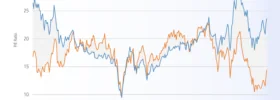Key TakeawaysRising interest rates and inflation may impede bonds from delivering the stable return streams they have had in the past.
Bonds have not consistently delivered diversification over time, and we could be entering another prolonged period where stocks and bonds are positively correlated.
We believe a 60/20/20 portfolio allocation may offer more stable returns and better diversification than the traditional 60/40 portfolio.
Consisting of 60% stocks and 40% bonds, this classic investment portfolio has historically been a trusted and reliable way to generate returns and diversify investor portfolios. However, we believe the traditional 60/40 allocation may now be working against investors.
In addition to elevated inflation and fluctuating interest rates, the potential for positive correlation between stocks and bonds could undermine the advantages of a traditional 60/40 portfolio. And, while bonds will continue to play a vital role in a balanced portfolio, we believe it may be time to consider the 60/20/20 investment allocation. Here’s why:
Bonds are Vulnerable to Fluctuating Interest Rates
Bonds have largely provided balance in investment portfolios. When stocks zigged, bonds zagged, and vice versa. Their role as a diversifier in a 60/40 portfolio has been a successful formula for attractive risk-adjusted returns* that has worked well over the last thirty years in a period of declining interest rates. Today with interest rates rising, we believe the 60/40 portfolio is subject to interest-rate risk. Consider these scenarios:
• If interest rates go down, the value of currently held bonds rises. However, reinvestment from maturing bonds would be at lower interest rates, diminishing returns. We view this as a trade versus a strategic asset allocation decision.
• If interest rates rise, reinvestment of any maturing bonds would be at higher interest rates; however, the value of currently held bonds within the portfolio would decrease, stoking investor uneasiness. We also see this as a trade.
• Stable interest rates may be the best scenario for portfolios, assuming interest rates stay relatively high. The portfolio value is likely stable, and reinvestments will be made at reasonably attractive rates. However, rates will likely rise and fall over time, and predicting when changes might occur is difficult.
Bonds are Less Compelling Given Historical Performance
For decades, a 40% allocation to bonds was additive to a portfolio. More recently, however, as interest rates dropped, bond returns have declined.
Figure 1. Bloomberg Aggregate Bond Returns Have Declined Over Time
Source: FRED, Morningstar Direct. Past performance is not a guarantee of future results.
U.S. 10-Year Treasury Yield, January 1, 1980 – December 31, 2022.
While 1980 to 1990 offered attractive returns in bonds, each decade thereafter has delivered less attractive returns. And, even worse, the (admittedly) short period since 2020 delivered a return of -2.7% as of December 31, 2022. However, despite suffering the worst year (2022) since its inception in 1980, the Bloomberg U.S. Aggregate Bond Index has still returned 6.85%, a very respectable number. The question is, is it possible for bonds to deliver anything close to this in the future?
Since the Fed began raising rates in March 2022, bond yields have spiked. Notably, the 10-year Treasury yield is about 3.8%, as of December 31, 2022. While considerably higher than in recent history, is this yield sufficient for a 40% portfolio allocation when compared to longer-term history? Will a recession force the Fed to cut interest rates this year or next (likely causing bond yields to fall further)?
Stocks and Bonds Have Not Always Been Uncorrelated
In recent years, stocks and bonds have generally moved in opposite directions allowing bonds to serve as ballast in portfolios. More recently though, as the following chart shows, the two have started to move in tandem as they’ve become positively correlated. This last happened from 1966-1998, a time period not much different from the current environment, with elevated interest rates and inflation. A positive correlation between stocks and bonds doesn’t bode well from a diversification standpoint and it underscores the potential benefits to be gained by adding other asset classes and strategies historically uncorrelated to each of them.
Figure 2. Correlation Between Stocks and Bonds has Fluctuated Over Time*
Source: LoCorr Fund Management and Morningstar Direct. Monthly data as of March 31, 2023. *Average 3-yr rolling correlation between S&P 500 PR Index and 10-Year Treasury Maturity Bond Index.
In short, an environment of low, stable interest rates and moderate inflation contributed to the negative correlation experienced between stocks and bonds from 2000 to 2020, as shown in Figure 2. Notably, this correlation has turned sharply positive since 2020. Given that the current environment of rising rates and higher inflation may be root causes of the shift, we could be entering a prolonged period of positive correlation.
Consider the 60/20/20 Investment Allocation
With bond returns declining over the last 40 years and (now) moving in sync with stocks, we propose a 20% allocation away from bonds and into assets with a low correlation to both fixed income and equities.
Over the last four decades (1980-2020), including a 20% allocation to a low-correlating sleeve would have been additive to a portfolio not only from a return standpoint but also in terms of Sharpe Ratio, or risk-adjusted returns.
Figure 3. The 60/20/20 Allocation Outperformed over Historical Periods
Source: Morningstar Direct. Past performance is not a guarantee of future results. Time period is 1/1/80-12/31/22.
As Figure 3 shows, the 1980s was one of the best periods for the 60/40 portfolio, with returns of 15.9%. However, using a managed futures index, the CISDM CTA Index, as a proxy for a low volatility, low correlation sleeve, a hypothetical 60/20/20 allocation would have bettered that return at 19.3%. Additionally, the 60/20/20 had a better Sharpe Ratio, or risk-adjusted return, i.e., 0.8 versus 0.6 over the period.
The 1990s, 2000s, and 2010s also show better performance for the 60/20/20, albeit less dramatic than the 1980s when bonds returned 12.9%. The more recent period, beginning with 2020, shows the continued outperformance of a 60/20/20 portfolio returning 6.5% versus 3.8% for the 60/40 portfolio.
While we cannot predict how the current decade will turn out, we can say that over the 40+ year period shown in Figure 3, the 60/20/20 portfolio outperformed by more than 1%, and with a higher Sharpe Ratio. In other words, an allocation of $100,000 in 1980 would have grown to over $9M if invested in a 60/20/20 portfolio over the same time period.
Building More Resilient Portfolios for the Long-Term
With interest rate uncertainty, inflation, and the potential for positive correlation undermining the benefits offered by bonds, such as diversification and stable return streams, investors may wish to rethink a 40% allocation.
How should they modify the portfolio’s investment components? Think about a 60/20/20 mix that includes a 20% strategic allocation to strategies uncorrelated to both equity and bonds.
As our analysis shows, portfolios with allocations to low-correlating sleeves outperformed over the long term, added beneficial levels of diversification, and improved traditional portfolios’ overall risk/return profile. Markets are always shifting — up, down, and sideways. A low-correlating sleeve could be a critical component in keeping clients invested during times of stress and help them achieve their long-term financial goals regardless of what lies ahead.
Learn more about combining low-correlating strategies >


